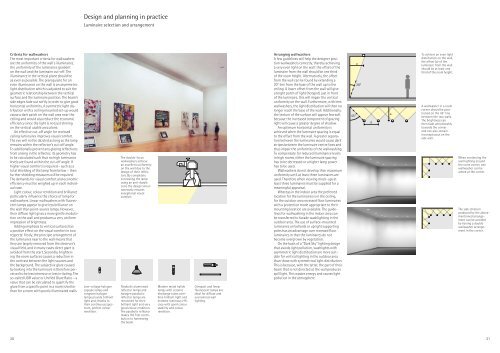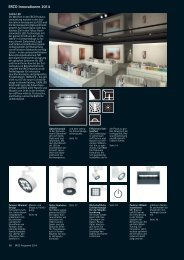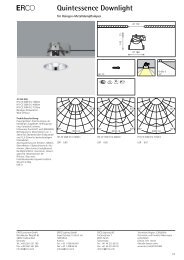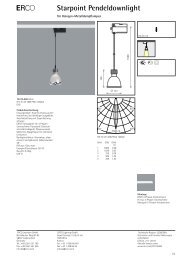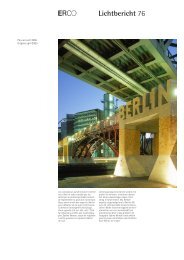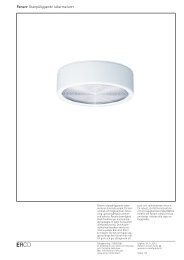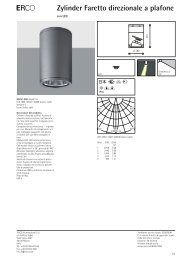Vertical Illuminance - Erco
Vertical Illuminance - Erco
Vertical Illuminance - Erco
You also want an ePaper? Increase the reach of your titles
YUMPU automatically turns print PDFs into web optimized ePapers that Google loves.
Criteria for wallwashers<br />
The most important criteria for wallwashers<br />
are the uniformity of the wall’s illuminance,<br />
the uniformity of the luminance gradient<br />
on the wall and the luminaire cut-off. The<br />
illuminance in the vertical plane should be<br />
as even as possible. The prerequisite for an<br />
even illuminance on the wall is an asymmetric<br />
light distribution which is adjusted to suit the<br />
geometric relationship between the vertical<br />
surface and the luminaire position. The beam’s<br />
side edges fade out softly in order to give good<br />
horizontal uniformity. A symmetric light distribution<br />
with a ceiling mounted set-up would<br />
cause a dark patch on the wall area near the<br />
ceiling and would also reduce the economic<br />
efficiency since the light is not just shining<br />
on the vertical usable area alone.<br />
An effective cut-off angle for recessed<br />
ceiling luminaires improves visual comfort.<br />
The eye will not be dazzled as long as the lamp<br />
remains within the reflector’s cut-off angle.<br />
To additionally prevent any glaring reflections<br />
from arising in the reflector, its geometry has<br />
to be calculated such that no high luminance<br />
levels are found within the cut-off angle. If<br />
higher visual comfort is required – such as a<br />
total shielding of the lamp from below – then<br />
further shielding measures will be required.<br />
The demands for visual comfort and economic<br />
efficiency must be weighed up in each individual<br />
case.<br />
Light colour, colour rendition and brilliance<br />
particularly influence the choice of lamp for<br />
wallwashers. Linear wallwashers with fluorescent<br />
lamps appear to give less brilliance on<br />
the wall than point-source lamps. However,<br />
their diffuse light gives a more gentle modulation<br />
on the wall and produces a very uniform<br />
impression of brightness.<br />
Adding emphasis to vertical surfaces has<br />
a positive effect on the visual comfort in two<br />
respects: firstly, the principle arrangement of<br />
the luminaires near to the wall means that<br />
they are largely removed from the observer’s<br />
visual field, and in many cases direct glare is<br />
avoided from the start. Secondly, brightening<br />
the room surfaces causes a reduction in<br />
the contrast between the light sources and<br />
the background. The subjective glare caused<br />
by looking into the luminaire is therefore perceived<br />
to be less intensive or less irritating. The<br />
so-called UGR value or Unified Glare Ratio – a<br />
value that can be calculated to quantify the<br />
glare from a specific point in a room is better<br />
than for a room with poorly illuminated walls.<br />
20<br />
Design and planning in practice<br />
Luminaire selection and arrangement<br />
Low-voltage halogen<br />
capsule lamps and<br />
tungsten halogen<br />
lamps provide brilliant<br />
light and, thanks to<br />
their continuous spectrum,<br />
perfect colour<br />
rendition.<br />
The double-focus<br />
wallwashers achieve<br />
an excellent uniformity<br />
on the wall due to the<br />
design of their reflectors.<br />
By completely<br />
concealing the lamp<br />
using an anti-dazzle<br />
cone the design simultaneously<br />
ensures<br />
exceptional visual<br />
comfort.<br />
Parabolic aluminised<br />
reflector lamps and<br />
halogen parabolic<br />
reflector lamps are<br />
renowned for their<br />
brilliant light and very<br />
good colour rendition.<br />
The parabolic reflector<br />
makes the first contribution<br />
to harnessing<br />
the beam.<br />
Modern metal halide<br />
lamps with ceramic<br />
discharge tubes combine<br />
brilliant light and<br />
extreme luminous efficacy<br />
with good colour<br />
stability and colour<br />
rendition.<br />
Compact and linear<br />
fluorescent lamps are<br />
ideal for diffuse and<br />
economical wall<br />
lighting.<br />
Arranging wallwashers<br />
A few guidelines will help the designer position<br />
wallwashers correctly, thereby achieving<br />
a very even light on the wall: the offset of the<br />
luminaire from the wall should be one third<br />
of the room height. Alternatively, the offset<br />
from the wall can be found by extending a<br />
20° line from the base of the wall up to the<br />
ceiling. A lower offset from the wall will give<br />
a bright patch of light (hotspot) just in front<br />
of the luminaire, this will impair the vertical<br />
uniformity on the wall. Furthermore, with lens<br />
wallwashers, the light distribution will then no<br />
longer reach the base of the wall. Additionally,<br />
the texture of the surface will appear less soft<br />
because the increased component of grazing<br />
light will cause a greater degree of shadow.<br />
An optimum horizontal uniformity is<br />
achieved when the luminaire spacing is equal<br />
to the offset from the wall. A greater separation<br />
between the luminaires would cause dark<br />
stripes between the luminaire centre lines and<br />
thus impair the uniformity of the wallwashing.<br />
To compensate for reduced illuminance levels<br />
in high rooms, either the luminaire spacing<br />
has to be decreased or a higher lamp power<br />
has to be used.<br />
Wallwashers do not develop their maximum<br />
uniformity until at least three luminaires are<br />
used. Therefore when viewing mock-ups at<br />
least three luminaires must be supplied for a<br />
meaningful appraisal.<br />
Whereas in the indoor area the preferred<br />
location for the luminaires is in the ceiling,<br />
for the outdoor area recessed floor luminaires<br />
with a protection mode appropriate to their<br />
mounting location are available. The guidelines<br />
for wallwashing in the indoor area can<br />
be transferred to facade washlighting in the<br />
outdoor area. The use of surface-mounted<br />
luminaires on bollards or upright supporting<br />
poles has an advantage over recessed floor<br />
luminaires in that the luminaires do not<br />
become overgrown by vegetation.<br />
On the basis of a “Dark Sky” lighting design<br />
that avoids light pollution, washlights with<br />
asymmetric light distribution are more suitable<br />
for vertical lighting in the outdoor area<br />
than those with symmetrical light distribution.<br />
This is because, with the latter, the part of their<br />
beam that is not directed at the wall produces<br />
spill light. This wastes energy and causes light<br />
pollution in the atmosphere.<br />
45<br />
To achieve an even light<br />
distribution on the wall,<br />
the offset (a) of the<br />
luminaire from the wall<br />
should be at least one<br />
third of the room height.<br />
A wallwasher in a room<br />
corner should be positioned<br />
on the 45° line<br />
between the two walls.<br />
The brightness can<br />
then fade unnoticeably<br />
towards the corner<br />
and can also remain<br />
inconspicuous on the<br />
side wall.<br />
When continuing the<br />
wall lighting around<br />
the room corner, one<br />
wallwasher can be<br />
aimed at the corner.<br />
The side striation<br />
produced by the abovementionedarrangement<br />
can be avoided<br />
by having a double<br />
wallwasher arrangement<br />
in the corner.<br />
21


